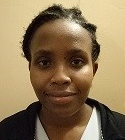Nancy Ngumbau, MBChB, MPH

Nominated From: University of Washington
Research Site: Kenya
Research Area: Infectious Disease
Primary Mentor: John Kinuthia
Research Project
Barriers and facilitators of uptake of Pre-exposure prophylaxis among pregnant and breastfeeding women aged 15-49 years in Homabay and Siaya counties
Pre-exposure prophylaxis (PrEP) is the use of antiretroviral drugs (Tenofovir disoproxil fumarate and Emtricitabine – Truvada) to prevent HIV acquisition. WHO recommends that PrEP should be offered to HIV seronegative individuals who are at substantial ongoing risk of HIV infection. Substantial risk is defined as having an HIV incidence of about 3 per 100 person-years or higher. A systematic review and meta-analysis by Alison et al 2014 (1), demonstrates that HIV uninfected pregnant and breastfeeding women in sub- Saharan Africa have a substantial but unperceived HIV risk with a pooled HIV incidence of 3.8/100 woman-years. This population is an important target group for PrEP because keeping them uninfected aids in eradicating pediatric HIV. Acute HIV infection during pregnancy and breastfeeding is associated with high maternal viral loads resulting in high rates (50% or higher) of mother-to-child transmission (MTCT) (2).
Pregnant and breastfeeding women acquire HIV through increased mucosal susceptibility when in stable partnership with HIV infected partner; recent partner HIV infection through external partnership; presence of sexually transmitted infections and resumption of sexual activity before complete healing (8). It has been observed that there are several challenges facing the existing HIV combination prevention strategies where women are unable to negotiate mutual monogamy, condom use or protection for themselves and their infants. For instance, condom use can prevent HIV infection. However, less than 10% of women use condoms in marriage despite a third of the women not knowing their partners’ HIV status and male partner HIV testing remaining low. As a result, the risk per coital act is high at nearly 0.5 per 1000 (3). PrEP is a promising HIV prevention strategy for women with limited personal prevention options. It will empower them to discreetly take control of their own HIV risk. Additionally, PrEP is highly effective (75%) (5, 9) with high adherence (4), has a good safety profile even during pregnancy (5, 6), is cost-effective in increased HIV incidence (6) and the risk of antiretroviral drug resistance is low.
Pilot programs for PrEP use have been conducted worldwide, including Kenya, among high risk populations such as serodiscordant couples, MSMs, people who inject drugs and commercial sex workers. These programs have not included the pregnant and breastfeeding women who have substantial ongoing but unperceived high HIV risk despite PrEP benefits. WHO has thus called for further research pertaining use of PrEP during pregnancy and breastfeeding but recommends for its administration. Kenya is one of the six HIV high burden countries with Nyanza province having the highest prevalence (15.3%) (7, 8). Homabay and Siaya counties in the province are the most affected with higher prevalence of HIV in women than men. This region provides an adequate sample population for this study.
Research Significance
The study seeks to identify individual and service delivery barriers and facilitators for uptake of pre-exposure prophylaxis (PrEP) for HIV prevention among pregnant and breastfeeding women aged 15-49 years in Homabay and Siaya counties in Kenya. The results of this study will inform the design of PrEP programs to ensure maximal uptake and effective delivery among pregnant and breastfeeding women to prevent primary HIV infection to women, as well as mother to child transmission. The results of this study would be relevant to any pregnant or breastfeeding women – in Kenya, the United States, or other country where HIV transmission occurs and PrEP is available.
Specific Aims
MAIN OBJECTIVE
1.To explore the barriers and facilitators for the uptake of pre-exposure prophylaxis among pregnant and breastfeeding women aged 15-49 years in Homabay and Siaya counties.
SPECIFIC OBJECTIVES
1. To explore the individual barriers and facilitators for the uptake of pre-exposure prophylaxis among pregnant and breastfeeding women aged 15-49 years in Homabay and Siaya counties.
2. To explore the service delivery barriers and facilitators for the provision of pre-exposure prophylaxis among pregnant and breastfeeding women aged 15-49 years in Homabay and Siaya counties.
Methodology
The study design will be a qualitative cross-sectional study carried out in Homabay and Siaya Counties. This area was selected because of its high prevalence of HIV. The study population will include HIV sero-negative pregnant and breastfeeding women aged 15-49 years at Homabay and Siaya counties seeking antenatal and post natal services. It also includes health care workers delivering services in Homabay and Siaya County Health facilities. For the pregnant and breastfeeding women, documented HIV negative rapid HIV test will be required at enrolment. The inclusion and exclusion criteria will be based on the Kenyan Guidelines of use of Antiretrovitral Drugs in Treating and Preventing HIV 2016.
The selected pregnant and breastfeeding women will then undertake in-depth interviews and Focused Group Discussions to determine the individual barriers and facilitators for the uptake of PrEP. Written informed consent shall be required before the start of the sessions. Health care workers delivering services in Homabay and Siaya County Health facilities will also be interviewed on the service delivery barriers and facilitators for the provision of pre exposure prophylaxis.
Purposive sampling will be used to select the study population since these women have a distinct social, demographic, sexual networks and partnership characteristics. The interviews shall be conducted in English, Kiswahili or Dholuo.
Mentors
- Dr. Grace John-Stewart, School of Public Health, University of Washington
- Dr. John Kinuthia, Dept. of Obstetrics & Gynecology, University of Washington, Kenyatta National Hospital
